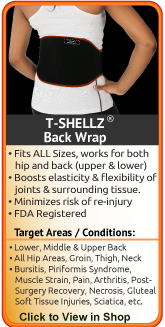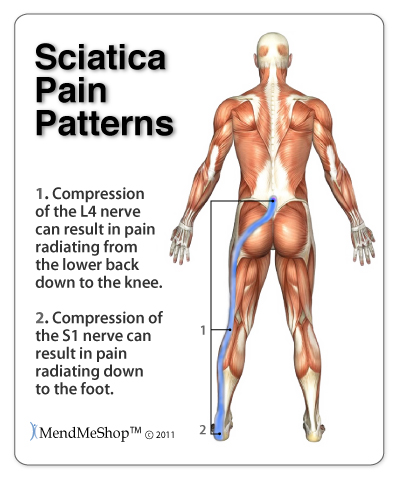Treating Sciatica Pain
Sciatica, also called sciatic neuritis, is used to describe symptoms of pain, tingling, numbness and weakness that can radiate from the lower back all the way down to the foot.
These symptoms result from the compression or irritation of one of 5 nerve roots in the spine (sacral nerves S1, S2, or S3 or lumbar nerves L4 or L5) that connect and form the 2 sciatic nerves, or pinching or irritation of the sciatic nerve itself.
The sciatic nerve is the longest and thickest nerve in the body, and originates in the lumbar spine. It then runs down through the buttock area and continues along the back of the leg and branches off to the tibial and common fibular (peroneal) nerves down to the foot.

In most cases, when a sciatic nerve is compressed only one side is affected with pain, although the pain may alternate from one side to the other. Occasionally, the pain is felt on both sides of the lower back and legs.
Although sciatica pain can be debilitating, most people who suffer from sciatica can find pain relief with non-surgical treatments such as cold compression for swelling reduction and the use of a TShellz® Circulatory Boost Wrap. It is a condition that usually gets better with time and rest. Treating the cause of the nerve compression is important to prevent sciatica pain from returning.
Causes of Sciatica
Sciatica symptoms are caused by the sciatica nerve being compressed. This compression can occur for a number of reasons in various locations and treatment will depend on the cause.
- A herniated or slipped disc in the lumbar or sacral spine
- Strain, inflammation, and swelling of the piriformis muscle (piriformis syndrome)
- Pregnancy
- Poor posture
- Short leg syndrome
- Wearing high heels
- Overcompensating for other injuries in the knee (ACL injury), lower leg (shin splints), ankle (sprain) or hip (bursitis)
- Damage to the vertebrae in the lumbar or sacral spine
- Disc degeneration in the lumbar or sacral spine
- Tumor in the spine
- A sharp blow or injury to the lower back or buttock area causing injury to the pelvis
- Autoimmune disorders
Symptoms of Sciatica
- Pain, tingling or numbness that radiates through the lower back, buttocks, and down the back of the leg possibly as far as the foot
- Pain starts slowly and worsens after standing, sitting, bending backward, walking or sleeping at night
- Difficulty walking, bending and or sitting
- Muscle weakness in the hip and/or leg
Sciatica Treatment
Compression of the sciatic nerve can occur in various locations and the exact cause and location is not always known. Treating the symptoms can be helpful to manage the pain but treating the source of the compression will result in faster and effective sciatica relief. We recommend that you see your doctor for a proper diagnosis and to determine the cause of the compression on the sciatic nerve.
Many of our clients have found the Back-Hip TShellz Wrap® to be a powerful home treatment wrap when dealing with sciatica. Learn more about benefits from home treatments using the TShellz Wrap®.
Product specialists are available 9:00 am to 5:00 pm Eastern Standard Time Monday to Friday. If any question or concern arises, call us or simply send us an email at any time (we check our emails constantly all throughout the day and night.. even on holidays!). We will respond as soon as possible. North America Toll Free 1-866-237-9608
Outside North America +1-705-532-1671
Learn More About Hamstring Injuries & TreatmentsI want to learn more about Hamstring Post-Surgery Recovery I want to learn more about the TShellz® Circulatory Boost Wrap I want to learn more about Ice & Heat: Which Is Better For Treatment? I want to learn more about Stretching for the Hamstring I want to learn more about Soft Tissue Injury Treatments
During your recovery, you will probably have to modify and/or eliminate any activities that cause pain or discomfort at the location of your soft tissue injury until the pain and inflammation settle. Always consult your doctor and/or Physical Therapist before using any of our outstanding products, to make sure they are right for you and your condition. The more diligent you are with your treatment and rehabilitation, the faster you will see successful results!
| 







